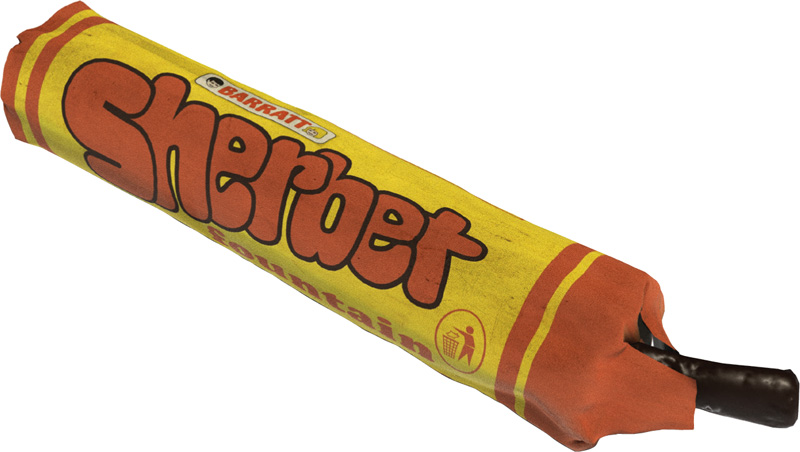
Memoirs of a geyser. Barratt’s Sherbet Fountain (1925).

Memoirs of a geyser. Barratt’s Sherbet Fountain (1925).
When Tangerine, the Blackpool-based owners of Sherbet Fountain, updated the sweet’s packaging in 2009, they faced a perfect storm of media outrage. ‘A step too far,’ seethed the Independent. ‘Killjoys,’ moaned the Daily Mail. ‘Annoying,’ fumed the Guardian. It was all rather predictable, given Fleet Street’s known aversion to change and bloodhound’s nose for stories that might rile the proletariat. ‘Hygiene’ was the self-confessedly anaemic reason Tangerine gave for the plastic makeover, though deaths attributed to virulent liquorice or toxic sherbet had been few and far between over the preceding eighty-odd years.
The new, hermetically sealed Sherbet Fountain genuinely did fix some flaws: it protected the product from moisture, avoided spillage on newsagents’ shelves and prevented sabotage. But – from the Just Williams to the Adrian Moles – generations of wilful kids had delighted in its original, eccentric form. Tucked in the back pocket, along with a catapult or a secret diary, that yellow paper tube looked pleasingly like a stick of dynamite or a (potentially name-coining) firework. Unpacked, the useless treacly liquorice ‘straw’ could be quickly dispatched and full attention directed to the contents within. If the weather was fine, this would most likely result in an explosion of dusty lemon sherbet and a day condemned to walk the streets with a pierrot-white face. If wet, the porous cardboard would dampen like a tramp’s roll-up, causing the sherbet to stick to the sides in claggy lumps and necessitating a lean-back and open-wide manoeuvre. Squeezing and tapping a fully loaded Sherbet Fountain into your mouth carried with it the risk, at the very least, of a full-on coughing fit.
Here’s where the modernisers went wrong. You can add as much anti-caking agent as you like, but take away that sense of danger and you subtract from the overall eating experience. Ironing out the wrinkles and streamlining defects might make sense on the factory floor, but what made the Sherbet Fountain so endearing was its essential Britishness: it was tactile, an action sweet, but nothing about it worked as it ought to. Like Morecambe and Wise sharing a big double bed, it sort of looked wrong, but it sort of felt right.
Barratt themselves had previously experimented with the formula, inflicting orange and raspberry varieties on an ungrateful public. In 1995, Monkhill also tried to tempt the nation into supping the Sherbet Fountain in soda drink form. Yet nothing scared the horses like plastic-gate, which was strange, because – in among all the hand-wringing over the less recyclable nature of the new tube – no one spotted that the flavour of the sherbet had also changed. Now, that one really should have had the journalists foaming at the mouth.